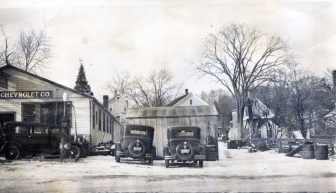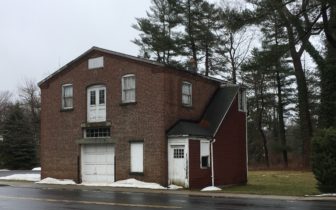It takes the perspective of time to balance the pace of progress working to shape the future versus the desire to preserve the past.
Lately in New Canaan it seems that the majority of projects proposing change and progress toward an ever changing future have been met with cries to preserve the past. I guess that is human nature at its fundamental best—the struggle to remember the past while pursuing the future.
Such is the plight of many buildings in New Canaan. There is no question that our town is fortunate to have a vibrant history that we should all be willing to embrace. At the same time, it is important to remember that New Canaan would not be the wonderful community it is today without the ever pressing beat of progress.

Karl Chevrolet was founded in 1927 by Leo and Email Karl, two of seven brothers. Photo courtesy of the Karl family
I will use the simple example of my family’s local business. My grandfather opened the doors to Karl Chevrolet back in 1927 in a building he leased from the town of New Canaan that had formerly been the town’s highway garage. A couple of years later, in 1929, he purchased the land and building from the town. Since then, the business has grown and evolved along with the rest of downtown New Canaan. That original building was renovated, added onto, partially torn down, rebuilt and today, while the business still operates on that original site, the buildings have evolved to keep pace.
Would I like to have that original building still intact? Sure I would. It would offer some outstanding historical perspective and be a cool place to visit. But if that building were still standing, our current business would not exist or would be located elsewhere; likely outside of New Canaan.
I use this example to illustrate why there are no easy answers to all of the swirling controversies on changing/renovating/tearing down old buildings. Look at history as a guide. Any society, community, nation or culture that thrives has at its core the drumbeat of progress. People, places and things all evolve. And for better or worse, when that progress stalls, stops or goes in reverse, that society, community, nation or culture begins an inevitable slide toward irrelevance.
In a free market, property owners have rights to develop their property within the bounds of current zoning regulations. When a project is proposed, as long as the project meets zoning requirements, it should be allowed to proceed. Thus, when I read stories about objections to private homes being renovated or torn down or objections to our town leaders making decisions to improve or replace our public buildings, I can’t help but to stop and wonder why.
Why does it take the threat of change to get some to react? Where were those voices before the change was contemplated? Let’s take the case of a red brick building on Richmond Hill Road that has sat vacant for twenty years and fallen into disrepair. If this is such a historically important building to our town, where have the voices of preservation been for those 20 years? Surely it would have cost a lot less to restore this building twenty years ago than it would today. And if the building was not fit to store antique fire trucks a decade ago, how can anyone think it would be fit to host team meetings and training sessions for youth baseball players today? There are problems looking for solutions and solutions looking for problems. This may be a case of the later.

The brick structure at 64 Richmond Hill Road. Credit: Michael Dinan
Sometimes the best intentions get caught up in the emotions of the day. In the case of the red brick building on Richmond Hill; there has been more than adequate time to deem this building worthy of preservation. I believe the buildings’ fate has been sealed by twenty years of vacancy and it is time to take it down.
In the case of the private residence on Oenoke Ridge Road where the current owner is seeking a demolition permit, I wonder where those who had wished to preserve it (the objection has since been withdrawn) where when the former property owner listed it for sale?
Life is full of choices. We all get up each day and make decisions as to how we will spend our time that day. Some will elect to spend their time dreaming up the future. Others will elect to spend their time preserving the past. In the end, we need both perspectives to be applied in balance. There is a time and a place for each and I would argue that interacting them at the very moment that the future is being created is not the ideal time.
A better, healthier interaction between the past and the future would be to proactively look for specific opportunities to create a plan to preserve the past while the future is being contemplated. How? By creating a catalogue of those properties and buildings, both public and private, deemed to have far greater historical importance. Then, as opportunity presents itself and any of these properties or buildings becomes available, seize the moment to try and preserve the past. It takes two willing parties to make this work—the property owner and those people interested in preservation. The process should be collaborative, not confrontational.
In the end, we cannot possibly preserve everything that is old. Everything works in moderation, so as a community, let’s commit to find a balance that works for everyone and change the public conversation from discord to collaboration.
Sincerely,
Leo Karl III
I think that Leo’s perspective is right on. To stop progress is the beginning of the end. The fact is that most of the historic buildings in New Canaan are privately owned by people that value them. They are willing to invest their own money in preserving the past and maintaining the character of the town. We are lucky to have them. Rich Townsend
Well said Well written
Let’s all move on
It’s an eyesore looming over the road and obscuring the park and nature
It may surprise you but there are hundreds of buildings in New Canaan – private, public, commercial, retail, etc. that are historic and worthy of preservation. For instance, most of the east side of Main Street is over 100 years old and well-preserved for the most part. I think most people would agree that our Landmarks include Town Hall (what remains of it) and the brick former bank building next to it, Vine Cottage, Red Cross House (former Episcopal manse), the Library, the Playhouse and the Bank of America Building, and of course our railroad station. Every effort must be made to preserve these structures and ensure that preservation architects are involved in their rehabilitation so they will contribute to our future. That way progress is enhanced by preservation, as it has been demonstrated in hundreds of American towns. Preservation architects are trained not only to preserve the best characteristics of the historic building, but also to design new additions and interior renovations that enhance the original design. As you drive around the country this summer, keep your eyes open for such projects “new uses for old buildings” for housing, office space, libraries, etc. Please send photos of such examples to the New Canaanite – the readership would love to see them!